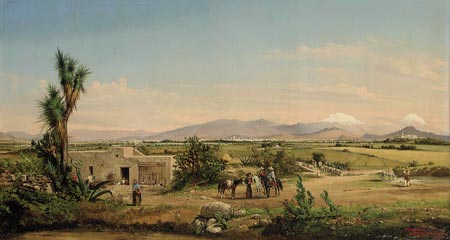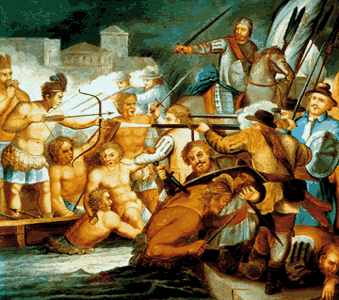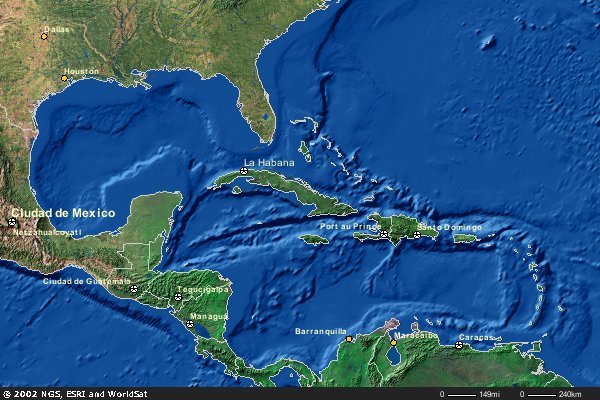Clarify
question | text | evidence | economy | map | infectious disease | epidemics | argument
What is the Caribbean?
How do biological and economic considerations create ecological history?
What did Columbus achieve?
Did the events of 1400-1600 change the world; if so how in each of these cases?
The text
In 1516, The Aztecs thought is was the year 13-Flint, "the year . . . before the invasion."
Artists imaginative rendering of the Aztec resistance to Spanish cavalry during the "Noche Triste."
p. 45.
". . . . central Mexico lay under the hegemony of the Aztecs."
"the end of his empire and of his world."
p. 45.
"Gods, however might come from the sea."
p. 46.
His structure:
1521
The fall of Tenochtitlán . . . was the worst. . . event in the Aztec's history. Worse, . . . the beginning of the most tragic century of their history."
"But the magnitude of the change, good and bad, was almost greater than the mind could encompass or the heart endure."
p. 47.
"some of the survivors were mestizos."
"In so many ways New Spain was new, a combination, crossing, and concoction of entities that had never existed before on the same continent."
p. 49.
". . . most powerful ally of all, the smallpox virus, also incubated in the Antilles."
p. 52.
" . . . were most important . . . Particularly to the invaders: pigs, cattle, horses, and pathogens."
p. 53.
"In the Antilles they rooted the Tainos' manioc tubers and sweet potatoes out of the ground, stole their guavas and pineapples, gobbled lizards and baby birds – everything went down their maws."
pp. 53-54.
"Swine explosions. . . "
"It may be that we distort reality if we try to count epidemics, plucking them up out of the surmounting tide of infection, but for the sake of getting some idea of the dimensions of the flood . . . "

"About fifty epidemics swept through the Valley of Mexico between 1519 an 1810."
p. 59.
Crosby's argument
Biological metamorphosis of the Americas is Crosby's point, or is it?
"The best ally of the invaders continues to be disease"
p. 60.
Creation of the Homogenocene or homogocene
". . .the biota of the two sets of continents on either side were markedly different,"
"Since then the biota of both, most undeniably of the Americas, have in significant part been the product of revolution, that is, the abrupt addition and explosive propagation of exotic species . . . ."
Columbus: "he mixed, mingled, jumbled, and homogenized the biota of our planet."
p.61.
pp. 45-61.
The economic transformation
"The gold and silver of Mexico and Peru helped drive an inflation that did more to disrupt Europe's class structure than anything since the Black Death."
discovery "smashed models of reality."
"Calories can make as much history as cannons–more in the long run."
p. 148.
pp. 148-166.
Map of the Caribbean
Infectious disease and the role of virgin soil epidemics in the creation of Caribbean people's mixed ethnicity
Crosby further argues that:
"But the great advantage of the Amerindians over Eurasians and Africans was in suffering from a smaller number of infectious diseases."
p. 83.
"Land is worthless without laborers."
p. 84-85.
"small colonies of merchants and their aids organized to carry on trade."
Hispaniola and the settlers revolt in 1499 against Columbus
"encomiendas, which were defined not as grants of land , but as grants of rights to the labor and tribute of the native communities."
p. 85.
"But then came the epidemics, which changed the colonists plans, all American societies, and Europe, –– indeed the entire world."
p. 85.
His second argument's structure:
- Epidemics
- The Worlds Greatest Labor Shortage
- Epidemics and Slaves
- Africa's Millions
- Europe's Millions
- An Interim Assessment
"The migrant pathogens and parasites obliterated millions of Amerindians, broke the morale of the survivors, and rendered vacant large parts of the New World, . . . ."
p. 93.
Virgin soil epidemics and depopulation
100 million native Amerindians in 1492; less than 10 million in 1900. Down from one sixth of the world's people in 1492.
"Virgin soil epidemics are those in which the populations at risk have had no contact within the lifetime of their oldest members with the diseases which strike them,. . . . immunologically almost defenseless."
p. 97.
"The thesis that epidemics have been chiefly responsible for the awesome diminution in the number of Native Americans is based on more than theory."
p. 97.
The great exceptions were the peoples of the peoples of the tropical lowlands and islands who, under the extra heavy burden of insect-borne fevers, mostly of African provenance [also tropical], held the downward course to oblivion."
Hence, the population of the Caribbean virtually vanished.
p. 99.
Measles and influenza are not "cured" by drugs or therapy.
pp. 100-101.
Successive epidemics versus simultaneous epidemics impact on the mental and physical health of the affected populations.
pp. 102-103.
"Native Americans had no conception of contagion and did not practice quarantine of the sick in pre-Columbian times, nor did they accept the new theory or practice until taught to do so by successive disasters."
p. 104.
Behavior:
"Panicky flight would serve more to spread the infection than to rob it of fresh victims."
p. 104.
European, Asians and Africans:
"They always brought death with them. . . . "
pp. 97-108.
Crosby's underlying assumptions from Germs Seeds and Animals.



